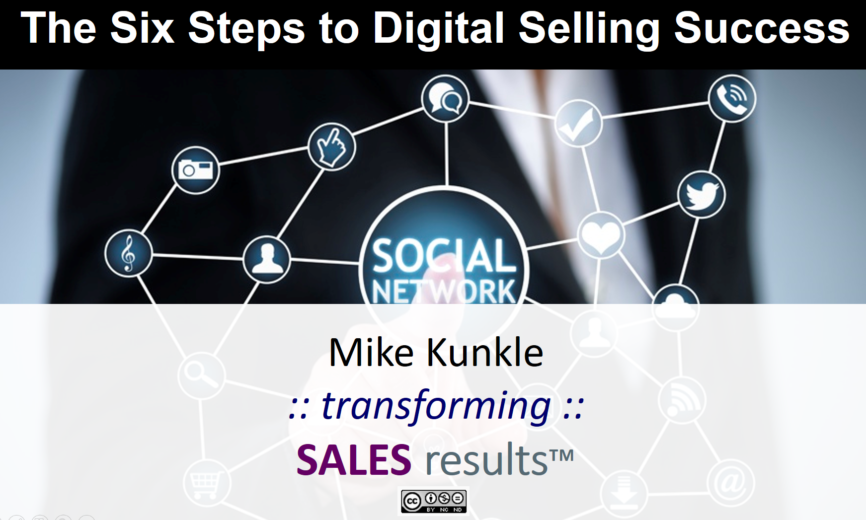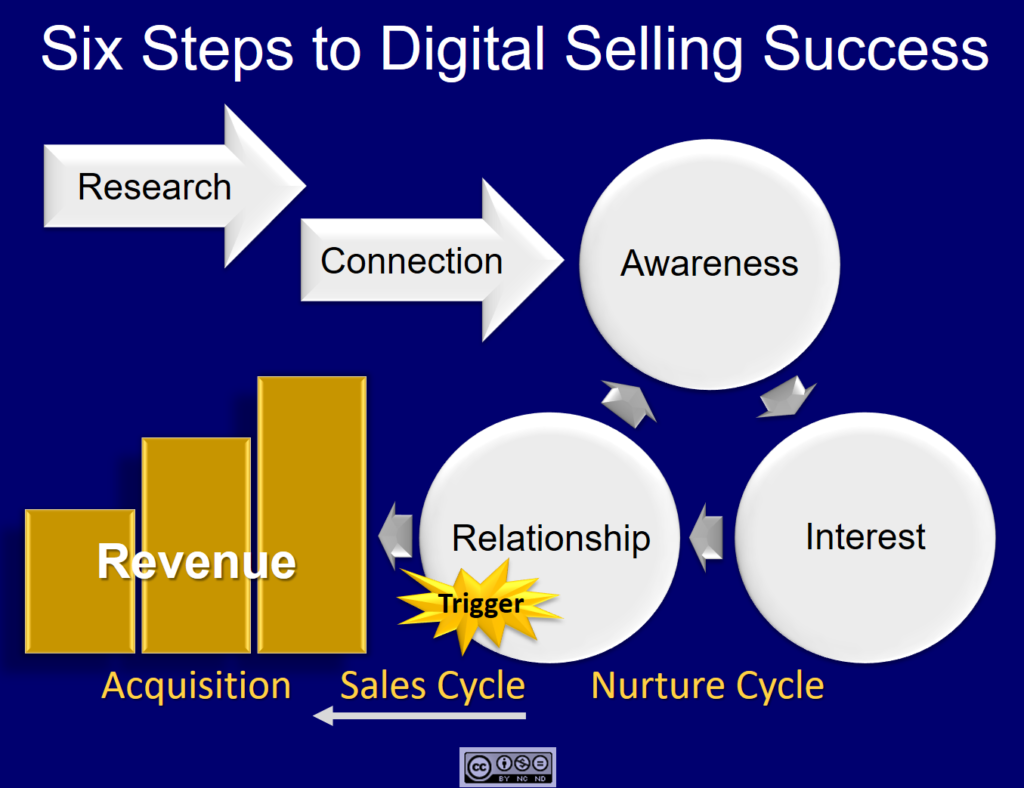Six Steps to Digital Selling Success

There’s a societal behavior pattern at work with social selling, which I find fascinating.
Shout It From The Rooftops
Have you ever noticed how we tend to shine a spotlight on the behaviors and social mores that we want to morph and replace with a “new normal?” By shining the spotlight on an issue and increasing awareness, over time, acceptance grows. I remember first learning about this in a sociology course in college, many years ago. Some societal examples:
- Minority groups and supporters lobby about the need for equality and diversity and foster a societal movement toward racial equality.
- Women’s groups and supporters espouse the leadership abilities of women and lobby for equal pay and opportunity and foster a societal movement toward gender equality in the workplace.
- LGBT groups and supporters campaign for acceptance and rights and foster a societal movement toward ending discrimination based on sexual preference.
The really interesting thing about this? You’ll know when we achieve equality on all three of these fronts, because one day you’ll wake up and these specific groups will be no more. Case in point – when was the last time you heard about women’s suffrage in the U.S., outside of a history class? Women in the U.S. can vote. That’s just “how it is.” (Like my favorite definition of company culture… “the way we do things around here.”)
The Drip Method of Change
A respected ex-coworker of mine was fond of saying that there are two ways that change happens. He made the point using a story about a glass of water. Let’s say you have a glass of iced tea. You want a glass of water. There are two ways to accomplish the change:
- Pour the tea down the drain and fill the glass with water. Boom! Done.
- Place the glass of tea under a faucet and turn the faucet to a slow drip. It might take a while, but eventually – you’ll have a glass of water. This latter method is very often how change occurs in our society and in our organizations.
The Social Explosion
What does all this have to do with social selling? Well, right now, we have a bunch of social selling thought leaders (many who support this growing cottage training industry), all advocating social selling like it is the greatest thing since sliced bread and the very thing that has or will completely revolutionize buying and selling, as we know it.
They are pushing, nudging, cajoling, persuading, lobbying, selling, influencing, sharing stats and success stories, and generally shouting from the rooftops and shining the spotlight on how social selling is the new normal, or the future, or both. For the record, many of these people are friends or respected industry connections, and in many cases, I think what they’re recommending is absolutely right. For some of us.
Sidebar: For those of you in the training profession, you might remember how audio tapes, video, CBT, and eLearning were all going to completely transform the training landscape (and especially kill off instructor-led training/ILT), right? And now, in the learning profession, it’s social learning, informal learning, mobile learning, flipped classroom, gamification, virtual ILT, virtual worlds, content curation, and more.
Seeing any patterns?
We’ll know social selling is truly part of the selling landscape, when we stop talking about it and shining the spotlight on it. Someday, it will just be “how we sell.”
Having said all this, I’d like to offer some thoughts about social selling today, and share some ideas on how to make the most of it, if it’s right for you. This could easily be a book, so it won’t contain everything, and I hope you will comment to add thoughts, debate what I’ve shared, or generally share your thinking on the topic.
A Word About the Phrase “Social Selling”

First, I wish we would stop calling it “social selling.” Huge misnomer. Has selling not always been social (in the sense that it occurs between people… not that it’s like attending a concert with friends or a family reunion)? To Bryan Kramer’s point, is it not H2H or human-to-human? Of course it is. Now, however, we have the opportunity to research, learn, connect, build awareness and interest, and forge relationships – all through social media and other online and digital resources – as part of (or before) the selling process begins. I’m not the only one who’s called out the misnomer, by the way. See the responses to Craig Rosenberg’s (TOPO) question on an older post, “What is social selling?” There are some pretty interesting comments on that post.
My Advice for Selling Through Digital Channels
Is Digital Selling Right For You? And how much?
The people who are doing much of the shouting don’t seem to ask this question often, but it’s key. I was really pleased to see Greg Alexander, formerly of Sales Benchmark Index, weigh in a few years ago (2014) with this post about the applicability of social selling by industry or vertical. While more and more business people participate in social media today than ever before, it’s still not adopted by all. Many C-suite leaders, who are often the target audience for B2B sellers, do not actively participate, so I still find Greg’s advice applicable today. The first two sentences lay it out clearly:
“The potential impact of Social Selling varies greatly by industry. Social Selling will be highly disruptive to some industries. Not so much to others.”
In short, fish where the fish are. If your buyers or those who can connect you to them are not using social media, or if social media efforts will not influence your buyers, your time is best spent elsewhere. If you’re selling into a market that has been disrupted by the social revolution, if you’re not maximizing these digital channels, you will eventually be left behind. As with most things, context and nuance matter. Make a purposeful decision about how much to engage in “social selling,” and when. Check out Greg’s post for some guidance. And see these other posts about sales nuance, because it matters a lot: Sales Nuance and more Sales Nuance.
For the remainder of this post, let’s assume your buyers are engaged in social media… on LinkedIn and possibly Twitter, Google+, SlideShare, Quora, Pinterest, Instagram, Facebook, SnapChat, etc…. and that selling through digital channels makes sense for you.
Laying the Foundation
There are three principles I can offer that will get you on the right track:
- Get There Now: Regardless of the time your buyers spend on social, you need a presence, a great profile, and some level of participation, right now.
- Devote Time Wisely: The amount of time you spend selling through digital channels should be dictated by the participation level of your buyers.
- Act Appropriately: The way you sell through social or digital channels should not be the same as through other channels.
The Ticket to Entry
Let’s start with Get There Now. Even if you can’t find your buyers, they’re doing Internet and social research, and can find you. For this reason, you need to consider The Three Ps.
The Three Ps of Digital Selling
- Presence
- Profile
- Participation
Presence
This is the “Get Their Now” piece. You need a presence, now, to be “findable” by your buyers. At a minimum, for B2B sales, this must include LinkedIn. Savvy buyers are researching you as much (or more) than you’re researching them. Even those who don’t participate a lot on social sites, will check you out.
Profile
You need a great profile, to make a great impression and establish credibility. I hope I don’t need to convince you or say more on this. Most profiles are relatively simple, but LinkedIn is by far the most complex. Don’t go it alone… there is a lot of great advice out there, much of it from social selling consultants.
You can see Gerry Moran’s LinkedIn profile advice at http://marketingthink.com/social-branding-how-to-create-the-perfect-linkedin-profile-blueprint/. He calls himself an evangelist, like many of the social selling advocates, but I find his advice to be realistic and balanced.
Here’s some other advice from Melonie Dodaro, Jill Rowley, and LinkedIn themselves:
- http://topdogsocialmedia.com/linkedin-marketing-infographic/
- https://www.linkedin.com/pulse/20140619154238-320966-are-you-a-linkedin-quota-crusher/
- https://business.linkedin.com/sales-solutions/blog/t/the-sales-professionals-ultimate-guide-to-linkedin-profile-optimization
Participation
You need to participate at some level. At a minimum, you should share content that is relevant to your buyers, including a mix of things from your company and other experts in your field. Beyond that, when asking to what degree you should participate in social media, the right answer is always about your customers. This is what I mean by “Devote Time Wisely.” Your level of participation should depend on how often and how deeply your customers, your prospects, and their influencers participate in social media. You can invest in research to determine how much of your market is participating, or you can start simply by searching for vertical markets and specific companies and people, to see how many are there.
Here’s an example for the machine tools industry from 2014, from a webinar I led at that time and a search I conducted to illustrate the variance between verticals. It’s not 3 million returns, but in 2014 it was at least 307K. Run that same search today and you’ll see 618,294 returns – doubled in 4 years. In addition, you can search for your customers, prospects, and others like them, as well as check for their centers of influence, as I illustrated with the original graphic from 2014:

Here’s the same search, run in 2018:

Back to the Centers of Influence concept… in the machine tools vertical, as the original graphic suggests, you can find and connect with owners, follow competitor companies, connect with analysts, CEOs and Presidents and other C-suite leaders, plant managers, application engineers, procurement managers, researchers/analysts, professors, tool and die pros, and as they adopt social media… your customers, prospective customers, and others like them.
The idea here is to “socially surround” your customers and their influencers, to firmly establish your presence and influence in the marketplace. You might think it’s odd that I included professors and researchers/analysts, but they could very well be influencers of some of your customers, and by connecting with them, you can also use them as a source of relevant industry content that you can share.
Sidebar: A Caution about Connecting on LinkedIn
Before we move on, I do need to offer a warning and some advice about connecting with people on LinkedIn. If you’re not familiar with LinkedIn’s Terms of Service or TOS, please read it, so you understand it. Yes, I know, I just said that you should actually read the TOS, and I mean it. If you invite people who don’t know you, and enough report that they don’t know you, you can lose your LinkedIn privileges. I don’t agree with this, but it’s how it is, today. There are ways that might help you avoid this, but it’s more than I can share in one post while covering this and the six steps. There is a lot of training out there about how to use LinkedIn for sales and that discusses this topic in more detail. I will at least say this… you should never send the stock LinkedIn invite – always customize it to tell people why you want to connect and the value to them (and it isn’t about how you can sell them something)… and whenever possible, use introductions to meet and connect with people that you don’t know.
In summary, this should help you determine whether the your target market and their influencers are on social, to warrant your participation. Determining their level of participation is more difficult by yourself, but you can observe over time, buyer by buyer as you’re researching, or again, invest in some market research with an agency or consultant who understands social media and social marketing, to see how your target market is participating.
Six Steps to Digital Selling Success

Here’s my approach, in a nutshell.
- Conduct Research
- Make a Connection
- Generate Awareness
- Create Interest
- Build Relationships
- Convert R2R (relationships to revenue)
From the R2R point forward, it’s all about strategic account management – either retention or growth, based on account potential. But today, even that includes social and digital elements. Fodder for another post. For now, let’s put a little oomph behind each of those bullets.
Research Buyers Through Digital Channels
If your buyers are engaged on social media, conducting sales research through social channels makes sense. If not, you can still set up alerts (think Google Alerts, Ambition, or check out Mention sometime), watch for Trigger Events, and conduct other online research to learn more about them. Possibilities:
- Review profiles on LinkedIn and other social sites
- See who they are connected to
- Learn which LinkedIn groups they belong to and if they are participating in discussions
- Observe which companies they follow
- Watch their status updates and if possible, which they comment on…
…basically, observing their digital footprint.
You can take this beyond standard social media sites and use a search engine and alert service, to see what else you can learn about them… philanthropic ventures, personal interests, alma mater ties, fraternal or association affiliations, community involvement, and more.
Connect and Create Multiple Digital Touches
From a sales perspective, studies abound to remind us how many touches it takes to get attention or make contact. From a learning perspective, the value of spaced repetition is well known, to increase retention. To be clear, I’m not recommending soliciting your buyers through multiple channels… I’m recommending:
- Following their digital footprint – being where they are
- Listening, observing, and learning about them
- Being part of their universe and creating multiple touch points
Build Awareness and Interest
If you hang where your buyers hang (aka, fish where the fish are), and are seen as part of their world, you’re halfway there. Now you need to interact with them in their sandbox, to move from general recognition toward awareness of your expertise and what you do. The goal here is to enhance credibility, begin building trust, and to offer value and generally be seen as a valuable resource.
The next step is to create interest. This is a blog post or book unto itself, but suffice it to say that the relevancy of your content and the things you purposefully share should be guided by the research you did to understand your buyer and their potential or real challenges. You’ll be able to gauge interest by their reactions and actions – downloads, likes, comments, shares, and questions or emails.
- Comment in their group discussions, to add value from your experience
- See what books they’ve listed on Goodreads, ask their opinion, and share some ideas
- Learn where they have traveled on TripIt and see what travel experiences you’ve had in common, and parlay it into a discussion about why they were traveling and what they are trying to accomplish
- Comment on presentations they posted or commented on, on SlideShare… lead to a discussion about what they’re doing or an interest or need
- RT something they seem passionate about on Twitter… share your approval or interest in the topic
…basically, using what you learned about them to forge a connection, build awareness, and generate interest.
Put Relationships First
This advice isn’t meant to be as linear as the rest. This is just a good principle to adhere to, in social and digital channels. I’d like to say this isn’t news, because the pundits all talk about how relationships come first. But realistically, the advice is often unheeded by the hungry horde of reps that see LinkedIn as a massive email marketing database.
In many cases, these reps immediately enroll new connections to their marketing automation systems or newsletters, without any opt-in or warning, simply because you connected with them. Or worse, immediately after connecting, you get the boilerplate InMail solicitation, introducing them, their company, product and/or service, with a sloppy call to action for a meeting to “get your feedback” or “explore options for helping each other” or seeing “how we might do business together.” As smooth as 40-grit sandpaper, in many cases. Social approaches should be far more subtle. It’s not always possible, but it’s far better if you can “magnetize” them toward reaching out to you.
Sidebar: Exception to the Rule
If you’re reading this blog, you know I’m not anti-selling. I’ve spent a career supporting sales organizations. I do stand for sales excellence and believe we need to elevate the profession. But if there is a compelling reason to move quickly… a need being discussed openly in a LinkedIn group, a referral from a mutual colleague who believes their contact needs your help, an uncovered Trigger Event… don’t just sit there contemplating how you will wow them through your social savvy. As my friend Joanne Black says, pick up the damn phone!
Convert Relationships to Revenue (R2R)
B2B, B2C, now H2H. I could go on. We don’t need another acronym. But I like this one. If you can’t do this part, meaning R2R or converting Relationships-to-Revenue, social media is just a fun hobby.
Hobbies are nice, but they don’t pay the bills, they don’t make your number, they don’t get you a ticket for the President’s Club cruise, and they don’t earn your spot on next year’s sales team at your current company.
The timeframe will vary and it’s not something I can tell you, without knowing more about your situation and context – but you need to move with purpose and clarity through the previous stages to get to this point of R2R “as soon as possible…” (and to paraphrase the quote about simplicity that is oft attributed to Einstein)… “…but no sooner.”
At this point, without knowing context, I always feel like the recommendations are generic and weak, but in general…
- Use a referral or introduction, if possible – preferably from someone you’ve helped or who will give you a favorable introduction.
- If possible, give to get, pay it forward, demonstrate servant leadership, or connect them to someone who might interest them, or help them in some way (or better, perhaps someone they can help).
- Always remember this “give to get” maxim, and be a provider of valuable information and connector of people who can help each other… if you can help your prospect in some way, prior, it will help open the door for your R2R approach
- Leverage news, Trigger Events, social comments, press releases, your research (something you read about your prospect company in their recent 10-K, perhaps) or what you know from another connection, as a reason to reach out and create or shape an opportunity and begin the opportunity pursuit process.
Some Other Considerations for Digital Selling
If you don’t want people to know you are researching them or don’t want to hint to competitors that you are researching a company or prospect, you can hide activity on LinkedIn, hide your connections, avoid commenting to them in the groups (until you’re ready to make a public connection). I don’t personally hide my activity, but I know many cautious sales pros who do. Pros and cons.
Social media can be a huge time suck for little return, if not managed well. Many sales people are completely overwhelmed by various sites, choices to make, which tools to use, and how to automate effectively, to be able to maximize time spent researching and engaging, rather than doing the mundane tasks. Plus, sales people who are still getting great or good-enough results with old methods, will see no reason to switch, until social becomes so ubiquitous that they will start to lag in performance or even miss targets, because they didn’t change gears soon enough.
In closing, please don’t hear what I’m not saying. I think digital selling is mandatory in some cases, and an incredibly smart and necessary strategy. In other cases, it’s good idea to start migrating toward it. And yes, in some (and probably far fewer cases today) it’s a downright a waste of time. When it’s time for you to make the move or further hone your approach, be smart and be a pro about it.
_____________________________________________________________
Well, that’s it for this post on selling through digital channels. As usual, this is what I think. More importantly, what do YOU think?
I’d enjoy hearing your thoughts in the comments.
Thanks for reading, be safe out there, and by all means — let’s continue to elevate our sales profession and evolve, elevate and professionalize the Sales Enablement function.
Mike Kunkle
-
Get connected / follow my content:
- Blog: https://www.mikekunkle.com/blog
- LinkedIn Publisher Posts: http://bit.ly/MikeKunklePublisher
- Digital Transformation, Inc. Blog: http://www.dxform.io/blog
- Sales Transformation Straight Talk Webinars: http://bit.ly/STSTonSMM
- The Sales Experts Channel Webinars: http://bit.ly/SalesExpertsChannel
- LinkedIn: https://www.linkedin.com/in/mikekunkle
- Twitter: https://twitter.com/mike_kunkle
- SlideShare: http://www.slideshare.net/mikekunkle

